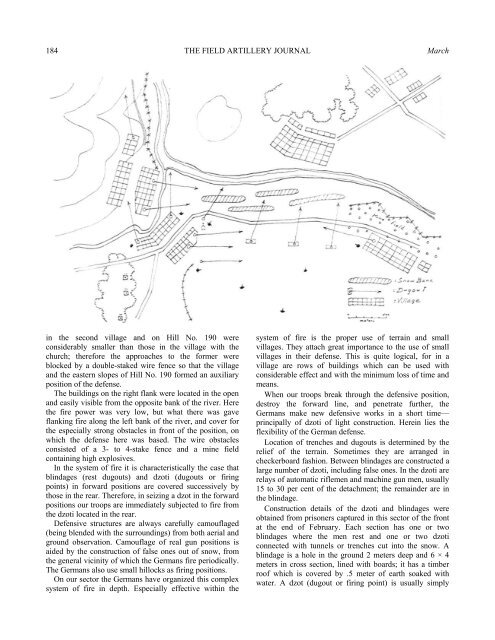the field artillery journal - Fort Sill - U.S. Army
the field artillery journal - Fort Sill - U.S. Army
the field artillery journal - Fort Sill - U.S. Army
Create successful ePaper yourself
Turn your PDF publications into a flip-book with our unique Google optimized e-Paper software.
184 THE FIELD ARTILLERY JOURNAL March<br />
in <strong>the</strong> second village and on Hill No. 190 were<br />
considerably smaller than those in <strong>the</strong> village with <strong>the</strong><br />
church; <strong>the</strong>refore <strong>the</strong> approaches to <strong>the</strong> former were<br />
blocked by a double-staked wire fence so that <strong>the</strong> village<br />
and <strong>the</strong> eastern slopes of Hill No. 190 formed an auxiliary<br />
position of <strong>the</strong> defense.<br />
The buildings on <strong>the</strong> right flank were located in <strong>the</strong> open<br />
and easily visible from <strong>the</strong> opposite bank of <strong>the</strong> river. Here<br />
<strong>the</strong> fire power was very low, but what <strong>the</strong>re was gave<br />
flanking fire along <strong>the</strong> left bank of <strong>the</strong> river, and cover for<br />
<strong>the</strong> especially strong obstacles in front of <strong>the</strong> position, on<br />
which <strong>the</strong> defense here was based. The wire obstacles<br />
consisted of a 3- to 4-stake fence and a mine <strong>field</strong><br />
containing high explosives.<br />
In <strong>the</strong> system of fire it is characteristically <strong>the</strong> case that<br />
blindages (rest dugouts) and dzoti (dugouts or firing<br />
points) in forward positions are covered successively by<br />
those in <strong>the</strong> rear. Therefore, in seizing a dzot in <strong>the</strong> forward<br />
positions our troops are immediately subjected to fire from<br />
<strong>the</strong> dzoti located in <strong>the</strong> rear.<br />
Defensive structures are always carefully camouflaged<br />
(being blended with <strong>the</strong> surroundings) from both aerial and<br />
ground observation. Camouflage of real gun positions is<br />
aided by <strong>the</strong> construction of false ones out of snow, from<br />
<strong>the</strong> general vicinity of which <strong>the</strong> Germans fire periodically.<br />
The Germans also use small hillocks as firing positions.<br />
On our sector <strong>the</strong> Germans have organized this complex<br />
system of fire in depth. Especially effective within <strong>the</strong><br />
system of fire is <strong>the</strong> proper use of terrain and small<br />
villages. They attach great importance to <strong>the</strong> use of small<br />
villages in <strong>the</strong>ir defense. This is quite logical, for in a<br />
village are rows of buildings which can be used with<br />
considerable effect and with <strong>the</strong> minimum loss of time and<br />
means.<br />
When our troops break through <strong>the</strong> defensive position,<br />
destroy <strong>the</strong> forward line, and penetrate fur<strong>the</strong>r, <strong>the</strong><br />
Germans make new defensive works in a short time—<br />
principally of dzoti of light construction. Herein lies <strong>the</strong><br />
flexibility of <strong>the</strong> German defense.<br />
Location of trenches and dugouts is determined by <strong>the</strong><br />
relief of <strong>the</strong> terrain. Sometimes <strong>the</strong>y are arranged in<br />
checkerboard fashion. Between blindages are constructed a<br />
large number of dzoti, including false ones. In <strong>the</strong> dzoti are<br />
relays of automatic riflemen and machine gun men, usually<br />
15 to 30 per cent of <strong>the</strong> detachment; <strong>the</strong> remainder are in<br />
<strong>the</strong> blindage.<br />
Construction details of <strong>the</strong> dzoti and blindages were<br />
obtained from prisoners captured in this sector of <strong>the</strong> front<br />
at <strong>the</strong> end of February. Each section has one or two<br />
blindages where <strong>the</strong> men rest and one or two dzoti<br />
connected with tunnels or trenches cut into <strong>the</strong> snow. A<br />
blindage is a hole in <strong>the</strong> ground 2 meters deep and 6 × 4<br />
meters in cross section, lined with boards; it has a timber<br />
roof which is covered by .5 meter of earth soaked with<br />
water. A dzot (dugout or firing point) is usually simply

















